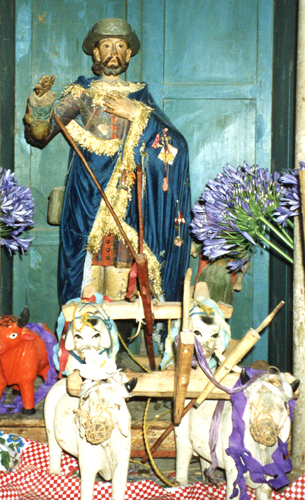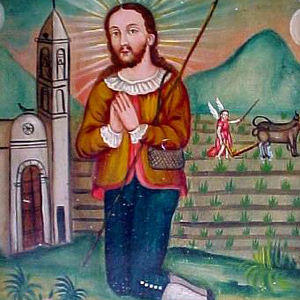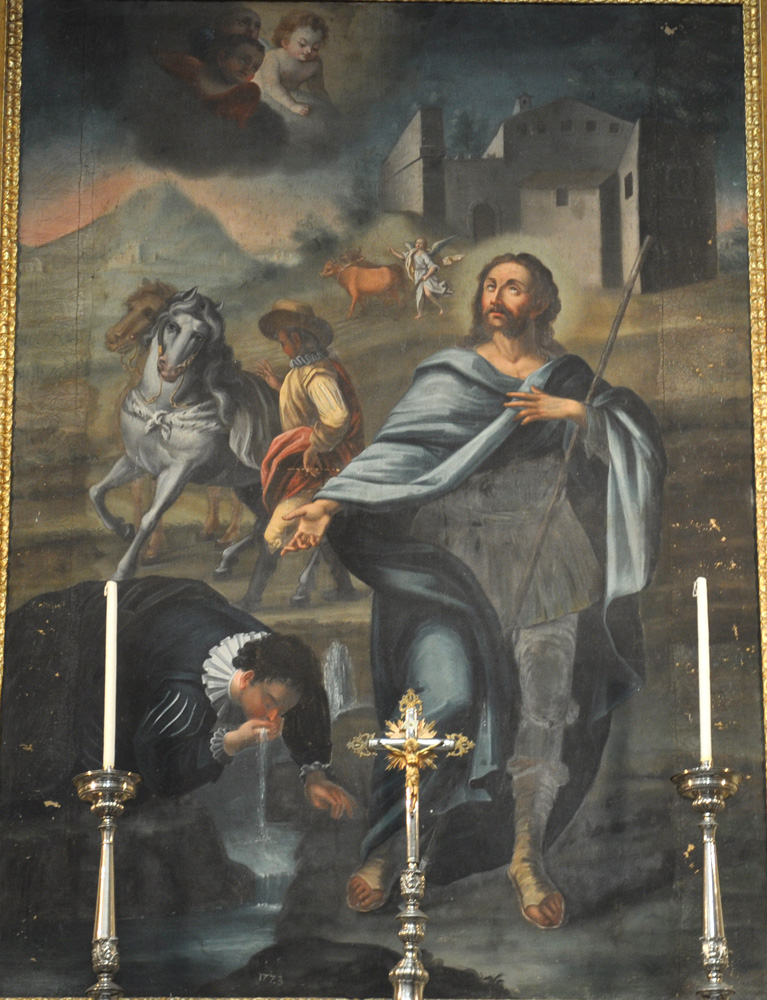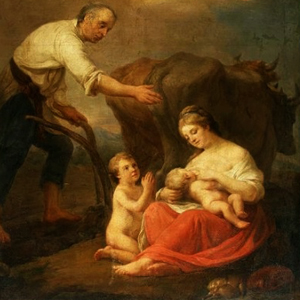THE ANGELS AND THE OXEN
The miracle for which Isidore is most renowned was observed by Juan Vargas one morning. The other workers had complained that Isidore was spending most of the morning at prayer in church each day, but when Vargas asked him about it Isidore assured him that his prayers would make the land more fruitful and that all his work would indeed get done. Vargas wondered how the latter could be possible, so he went secretly one morning to observe. What he saw was two angels helping Isidore with the plowing, each angel leading a yoke of white oxen.In memory of this miracle, countless churches in Latin America have statuary groups with the saint leading a yoke or team of white oxen, as in the first photograph at right. Other churches display paintings like the second one at right, with the saint praying at church and the angels already at their plows. Various images use various combinations of the saint's traditional garb: a flat-topped hat, a short jacket with a broad white collar and white cuffs, pants reaching to the knee or mid-thigh, and stockings or leggings.
The growing of maize is often featured in images of the saint in Mexico, where it is the primary native crop (example), and in New Mexico as well (example).
WATER MIRACLES
Sometimes Isidore is shown with a long rod or goad, as in the images at right. This refers both to the oxen miracle and to another story witnessed by Juan Vargas and related in the 17th century in Jaime Bleda's Vida y Milagros del Glorioso San Isidro (293). One day while visiting the saint Vargas happened to mention how thirsty he was. At that, Isidore directed him to a rocky place where it would not seem there could be any water. He struck the ground with his ox-goad, and a spring burst forth (image). This was the first of many occasions when the saint made springs available where none had been.A HOLY FAMILY
In the modern age Isidore's marriage to María Torribia has been taken to exemplify to holiness of the Christian family. Thus a painting from 1805 (the bottom image at right) borrows from Holy Family iconography to stress the holiness of Isidore's family. (Compare it with this painting of the Holy Family by Andrea del Sarto.) Alonzo Cano's Miracle of the Well is a sort of family portrait, picturing the miracle narrated in María's vita (Bleda, 214): Their son Juan fell into a well and drowned, but Isidore and María knelt to pray and miraculously the water in the well rose up to the brim, carrying the living child with it.The couple's status as a "holy family" continues even in the 21st century. In Ohio, a newly formed Catholic parish boasts of being "the first parish of our diocese to be given married patron saints" in an About us page that summarizes the lives of Isidore and María. (The summary carefully omits the claim in Bleda [214] that after Juan died the couple chose to live as brother and sister.)
Torrelaguna, near Madrid, honors María and Isidore with an annual romería in which the people accompany a yoke of oxen that pulls a wagon with statues of the couple to the hermitage where María lived after Isidore's death (photo).
Prepared in 2014 by Richard Stracke, Emeritus Professor of English, Augusta University
HOME PAGE

A santo of St. Isidore in Teitipac, Oaxaca, Mexico (See the description page for full photo and further information)

A cuadro of St. Isidore from a private collection (See the full image)

Isidore strikes a rock and water flows for Juan Vargas to drink (See the description page.)

Bacciarelli, St. Isidore – The Blessing of Work, 1805 (See description page for full image and further information)
MORE IMAGES
- A statuette group of St. Isidore and his oxen.
- 1866: A painting of the saint and his miracles by the Bolivian artist Joaquin Castañon.
DATES
- Lived from 1070 to 1130
NAMES
- The Spanish name San Isidro Labrador is sometimes translated "St. Isidore the Farmer," but "farmer" implies a degree of independence foreign to the culture of his time. Labrador can also be translated "yeoman" or "cottager." These terms, though appropriate, are never used for this saint.
NOTES
1 A short Latin version of the 1275 vita is available in Latin in Acta Sanctorum, May vol. 3, 514-21. A Spanish translation, with numerous interpolations and additions, is in Bleda, 16-305.